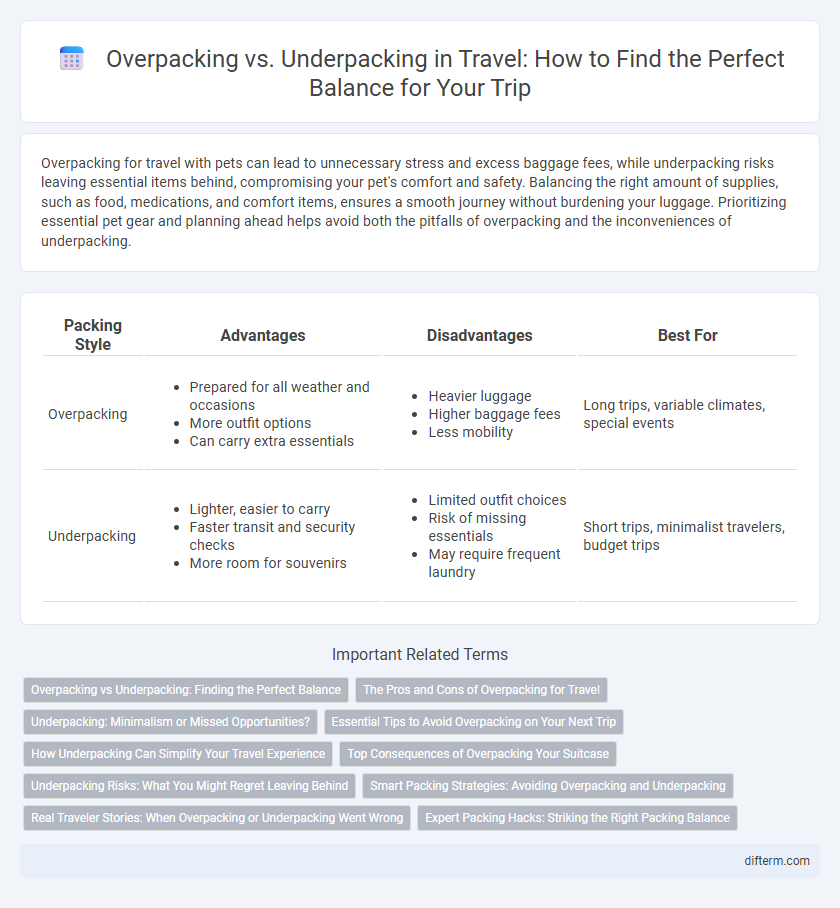Overpacking for travel with pets can lead to unnecessary stress and excess baggage fees, while underpacking risks leaving essential items behind, compromising your pet's comfort and safety. Balancing the right amount of supplies, such as food, medications, and comfort items, ensures a smooth journey without burdening your luggage. Prioritizing essential pet gear and planning ahead helps avoid both the pitfalls of overpacking and the inconveniences of underpacking.
Table of Comparison
| Packing Style | Advantages | Disadvantages | Best For |
|---|---|---|---|
| Overpacking |
|
|
Long trips, variable climates, special events |
| Underpacking |
|
|
Short trips, minimalist travelers, budget trips |
Overpacking vs Underpacking: Finding the Perfect Balance
Overpacking creates excess baggage fees and limits mobility, while underpacking risks missing essential items and comfort. Striking the perfect balance involves packing versatile clothing, prioritizing travel-sized essentials, and planning based on the destination's climate and activities. Efficient packing optimizes luggage weight and space, enhancing convenience and travel experience.
The Pros and Cons of Overpacking for Travel
Overpacking for travel ensures you have a wide variety of clothing and essentials, reducing the risk of forgetting important items but often leads to heavy luggage and additional fees. Carrying excess weight can cause physical strain during transit and limit mobility, especially in destinations requiring frequent movement or public transportation. However, having extra supplies can provide comfort and readiness for unexpected weather or activities, making overpacking a strategic choice for certain trips.
Underpacking: Minimalism or Missed Opportunities?
Underpacking promotes travel minimalism by encouraging a lighter, more manageable load that enhances mobility and reduces stress. However, it can lead to missed opportunities when essential items or outfit choices are insufficient for unexpected activities or weather changes. Balancing minimalism with practical preparation ensures travelers stay flexible without sacrificing comfort or experience.
Essential Tips to Avoid Overpacking on Your Next Trip
Packing smart saves both time and space; prioritize versatile clothing items that can be mixed and matched to create multiple outfits. Use packing cubes to organize and compress belongings, preventing unnecessary bulk in your luggage. Make a checklist of essentials based on your destination's weather and planned activities to avoid bringing non-essential items.
How Underpacking Can Simplify Your Travel Experience
Underpacking streamlines your travel experience by reducing physical burden and increasing mobility, allowing easier navigation through airports and urban spaces. Carrying fewer items minimizes stress related to lost luggage and overstuffed bags, facilitating faster security checks and baggage handling. This minimalist approach encourages thoughtful packing, ensuring only essential items are included, which enhances comfort and flexibility on any trip.
Top Consequences of Overpacking Your Suitcase
Overpacking your suitcase often leads to excess baggage fees, limited mobility, and increased travel stress, significantly impacting the overall travel experience. The added weight can cause physical strain and slow down airport navigation, while bulky luggage reduces space for essential items or souvenirs. Efficient packing enhances convenience, saves money, and streamlines transit, making overpacking a critical issue for frequent travelers.
Underpacking Risks: What You Might Regret Leaving Behind
Leaving essential items behind when underpacking can lead to discomfort and inconvenience, such as missing medication, insufficient clothing for weather changes, or lack of toiletries. Travelers may face unexpected expenses purchasing forgotten necessities at often higher prices in unfamiliar locations. Underpacking also limits flexibility for spontaneous activities or emergencies, increasing stress and reducing enjoyment during the trip.
Smart Packing Strategies: Avoiding Overpacking and Underpacking
Smart packing strategies balance essential items with space efficiency to prevent overpacking and underpacking. Utilizing versatile clothing pieces and packing cubes streamlines organization, ensuring travelers carry what they need without excess weight. Prioritizing multifunctional gear and creating a checklist tailored to the trip duration and activities helps maintain optimal luggage size and convenience.
Real Traveler Stories: When Overpacking or Underpacking Went Wrong
Real traveler stories reveal costly mistakes caused by overpacking, such as heavy luggage fees, strained backs, and missed connections due to slow airport navigation. Underpacking incidents often lead to uncomfortable situations like lacking essential clothing or toiletries, resulting in costly purchases or awkward social encounters. These experiences highlight the importance of balanced packing strategies tailored to trip length, climate, and planned activities.
Expert Packing Hacks: Striking the Right Packing Balance
Expert packing hacks emphasize prioritizing versatile clothing items and using packing cubes to maximize space and organization, preventing the pitfalls of overpacking. Selecting lightweight, multi-purpose gear helps maintain a balanced suitcase weight, while creating a detailed packing list tailored to the trip's duration and activities reduces the risk of underpacking essentials. Utilizing compression bags and rolling clothes further optimizes space, ensuring travelers bring everything needed without excess bulk.
overpacking vs underpacking Infographic

 difterm.com
difterm.com